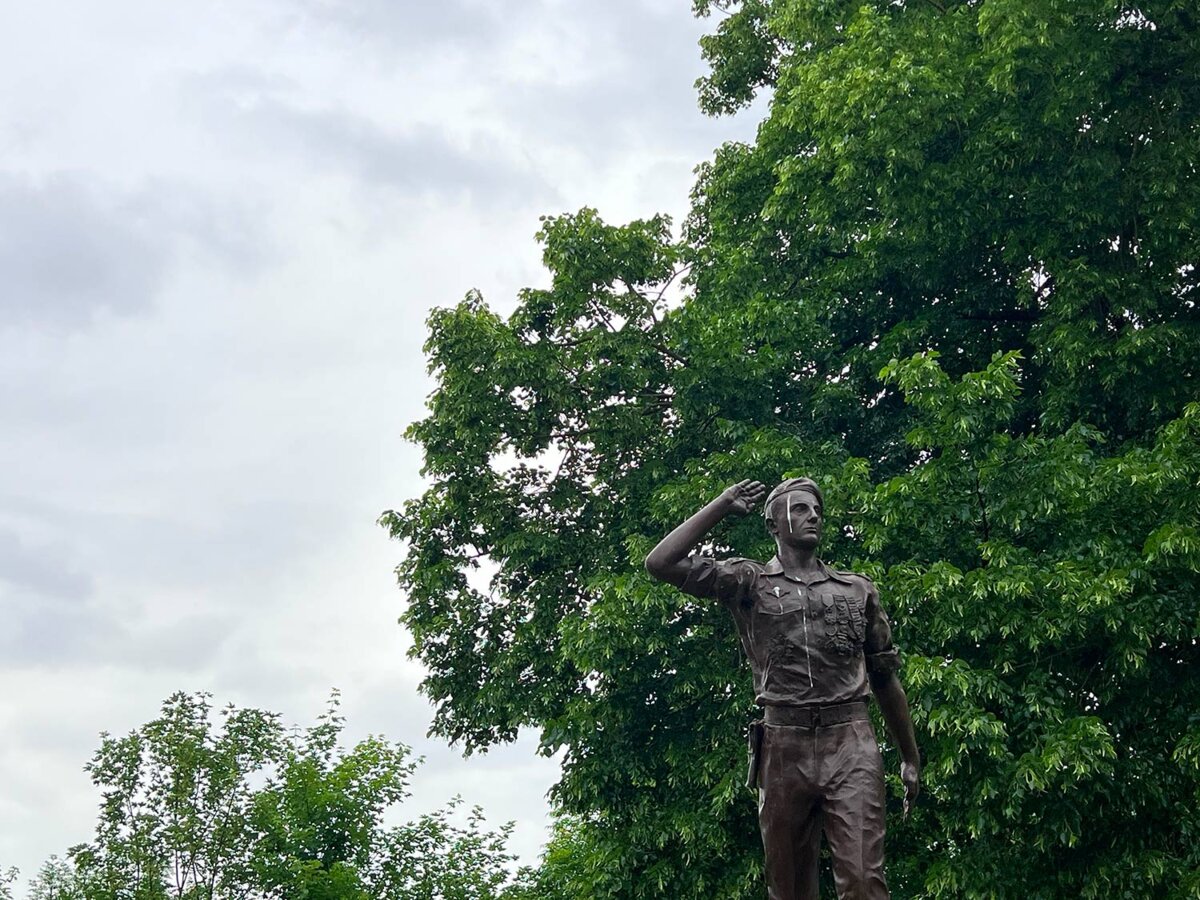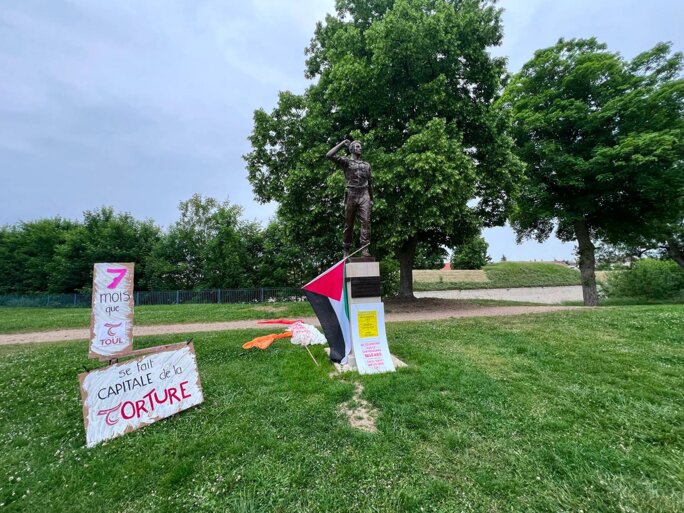“Photo, photo, photo!” giggle a handful of youths in front of the bronze likeness of a soldier standing to attention, his body leaning forward, a row of medals spread across his bulging chest and his eyes fixed on the horizon. A blackbird has just alighted on the military beret that tops this two-and-a-half-metre tall figure.
That bird is in fact perched on the statue of one of the most infamous symbols of the torture committed by French soldiers during the Algerian War of Independence: General Marcel Bigeard, who was born here in Toul in 1916. Yet despite Bigeard's infamous reputation, the municipal council of this small town in north-east France – run by leftwing councillors not affiliated to any major party - decided to honour the former senior military officer turned politician with this monument, and it was erected on October 24th 2024.
According to critics, this statue, carved by sculptor Boris Lejeune, a figure with close links to the far-right, appeared suddenly without prior fanfare. It went up “quietly one day, without a soul being told”, according to Samir Aridja, a history teacher from Toul who is deeply opposed to its presence.
Indeed, ever since its sudden appearance in a green space situated between the branch of a canal, a motorhome park and the nearby war memorial, this statue has sparked a fierce backlash from local people. So keen are some to have it removed that a local residents group has just filed legal action at the administrative court in nearby Nancy.
“MP for Toul and former minister”, reads the plaque accompanying the statue. Yet ever since the 1990s there have been stories of the brutal methods that Marcel Bigeard helped spread - and even taught - at the country's military academy during the 1950s. As early as 1987, a broadcast on France Culture public radio station shared testimony from another French general, Jacques Massu, describing Bigeard’s enthusiasm for “gégène”, a torture method using electric shocks on a prisoner's body that he is said to have learnt during France's war in Indochina. “We can't now decide that that is the past we want to celebrate. What we can do is confront it and listen to the historians, who have now proven everything,” says Sylvie Prévost, another native of Toul who is campaigning against the statue.

Enlargement : Illustration 1

“There’s not a shadow of doubt about the fact that he was one of the men who most embodied the abuses committed in Indochina and Algeria,” confirms historian Fabrice Riceputi. In fact in 2010, at the time of his death, the possible transfer of the former paratrooper’s ashes to the prestigious Les Invalides military site in Paris stirred strong opposition and the plan was eventually dropped.
'Breach of public order'
A group of local residents opposed to the statue has taken to gathering at this site in the early evening on the 24th of each month. On May 24th, around 40 of them unfurled small posters and banners reading “Stop colonial violence” and “Bigeard = torture = crimes against humanity”. In front of the plinth, white sheets stained with red temporarily covered the general’s face, alongside banners that read: “Toul has been the capital of torture for 7 months.” Sylvie Prévost herself calls the sculpture a “slap in the face”.
Mariam, 23, was among a handful of students visiting the site for the first time. For her, the bronze figure “rubs salt in the wound, as if there’s no desire at all to acknowledge the past or make amends”. The student, who is French of Algerian origins, continues: “The far-right is establishing itself everywhere, both in politics and in the public domain. The colonial past was violent in every form and today we're still subject to violence.” Sakina, a local woman who stumbled across the protest with her two children, adds: “It’s shameful that this man is there - I could weep.”
On Tuesday June 24th, the opponents went a step further and filed a case with the administrative court in Nancy. Mediapart has seen the legal complaint, which describes the statue as a “full-length, bronze apologia for the acts committed by this man in that uniform”.
The legal document argues that this “laudatory image of a man who planned, taught and carried out acts that were a serious attack on rights and basic freedoms, acts of torture and of war crimes, erected on public land in Toul, rightly shocks a large part of the population”. Those opposing the monument say that “in 2024, erecting a statue celebrating Marcel Bigeard, dressed as a soldier of colonialism, is a serious breach of public order”.
The plaintiffs also say the statue breaches the “principle of public service neutrality by which the town of Toul, like all public bodies, is bound”, on the basis that “there’s no doubt that in the struggle between seekers of historical truth and champions of colonial myth, the erection of this statue glorifying a notorious torturer and colonialist takes the side of the far-right”.
They have called for the statue to be removed from public land within one month and are seeking an order for the council to pay 2,000 euros to each of them.
I believe that just citing the status quo is not a good argument. Statues have been moved or taken down throughout history.
Several locals have chosen to add their names to this legal action, along with groups such as Collectif juillet 1961, founded in memory of the notorious “Night of the paras” in Metz, when four North Africans were killed on July 23rd 1961 in that north-eastern city.
Among the locals involved in the legal action is Samir Aridja, descended from a victim of torture in Algeria. When the statue went up, the teacher first thought it was a bad joke. He says: “When I found out that it came [at the behest of] a group linked to the far-right, and that the sculptor was too, I realised this wasn’t just a political blunder. It was serious. A major political mistake.”
His mother, Louiza Aridja, also plans to join the legal case, along with her husband. “It’s not right that we should see this,” says the pensioner. “I didn’t live through the war, I was born afterwards, but my parents did, my husband did too. And my in-laws as well. I heard terrible things [about Bigeard]. He gave the army orders to torture.”
“Some say that now the statue’s up, we’ve lost. Well, it’s there, but it can come down too, if the council sees sense or if the courts strike down the decision,” says Sylvie Prévost from Collectif juillet 1961. “I believe that just citing the status quo is not a good argument. Statues have been moved or taken down throughout history.”

Enlargement : Illustration 2

Despite repeated denials by Marcel Bigeard and his refusal to admit the truth of what he called “tough questioning”, which he claimed had been carried out “properly”, the general’s past is littered with damning accounts. These range from the repeated, systematic rapes by French soldiers described by FLN activist Louisette Ighilahriz in Le Monde in 2000 to the so-called “Bigeard shrimps”.
“That was a well-known phrase in Algiers in 1957, used for the bodies of Algerians found washed up by the sea. They’d been thrown from helicopters with their feet set in buckets of cement and sometimes they’d resurface,” explains historian Fabrice Riceputi.
“To raise a statue like this to a torturer, in spite of all the people’s struggles against colonisation, how can a town still accept such a thing today?” asks Mariam. “If this can happen in a leftwing town hall, what’s going on in a far-right one?” adds Samir Aridja.
The decision to put up the statue dates back to the town council meeting of June 26th 2018, more than six years before it was finally erected. The minutes show that the scheme came about after a “request by the Fondation Général Bigeard”, a foundation backed by the general’s daughter, who pledged to fund the project.
“The aim being to carry on the general’s work and memory, with a focus on passing on to the young the values of courage and love of the homeland shown by the general,” argued Anne-Marie Quenette, head of the foundation. The decision was passed unanimously, as confirmed by the council minutes.
“For us, it’s beyond belief, especially coming from a former Socialist Party mayor. They had every chance to reverse it. They didn’t. The mayor stuck to the decision,” says an angry Philippe Sidre from the Nancy branch of the human rights group the Ligue des droits de l’homme. “Once the campaign started, they still had time to backtrack. A council decision can be overturned.”
He’s one of the most decorated generals in France, if anyone had thought he’d committed reprehensible acts he’d have been stripped of his honours.
Samir Aridja, the history teacher, tries to make sense of the situation. “Either it’s cowardice, a lack of nerve from elected officials who bowed their heads to the far-right because he was from Toul and they thought he had to be honoured. Or it’s ignorance, a lack of knowledge…” Local woman Sakina is blunt: “When I see the people in charge in Toul today, they’re not idiots, they know what they’re doing.”
Contacted several times by Mediapart, the mayor of Toul, Alde Harmand, declined to comment. Questioned by L’Humanité newspaper back in March 2024, he said then: “Marcel Bigeard is an important person for Toul. He was born here, he died here. He’s one of the most decorated generals in France, if anyone had thought he’d committed reprehensible acts he’d have been stripped of his honours.”
“That's denialist talk,” historian Fabrice Riceputi tells Mediapart. When approached at the National Assembly, local MP Dominique Potier also declined to comment, saying he now hoped for a “period of appeasement”. Analysing the local support that exists for the former general, the socialist spoke of “Bigeard as a character”, the “warmth” of the “old soldier”, who won hearts despite a “huge dark side”.
The MP also pointed to a “very clear statement” he had already made and which was reported by L’Est républicain newspaper in May 2024. In it, he called for a “dignified way out”, saying the idea for the statue had failed in its “purpose” which had been to “inspire” and “bring people together”. He said: “We could, for instance, imagine it being moved to a museum, a place where the controversy could give way to education.” Some opponents of the Bigeard statue also support the idea of moving it to such a place. “To explain what he was,” says Sylvie Prévost.
The statue attracts more than just blackbirds and sparrows, it also draws supporters of colonial France. On June 18th, a gathering of some 40 people, both civilians and soldiers, was organised by a private individual to mark the 15th anniversary of the paratrooper’s death. Wreaths and soil from Dien Bien Phu, the scene of France’s crushing defeat in Vietnam in 1954 and Bigeard’s battlefield of glory, were laid at the foot of the bronze statue.
------------------------------------------------------------------------------
- The original French version of this article can be found here.
English version by Michael Streeter


